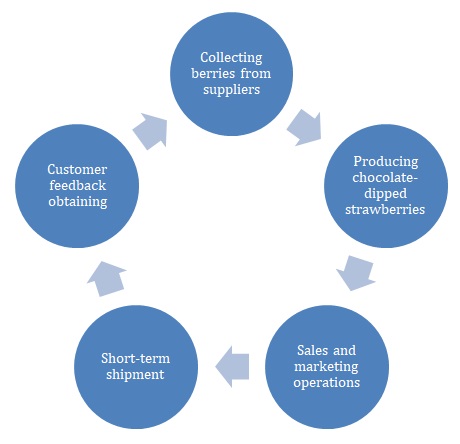Multiple tools are available and essential to use when making business management decisions. With the advancement of informational technologies, more and more industries and businesses benefit from using software for analysis and better-informed decision-making. The strawberry industry in general and the Labedo Berries company, in particular, also use business management tools to identify the best options for further development. The present paper aims at conducting a SWOT analysis to determine the critical factors in the strawberry business, discussing the application of the DevOps concept, and determining project management models for the business’s development.
The SWOT analysis method allows for identifying and interpreting the strengths, weaknesses, opportunities, and threats of a business. The SWOT analysis for Labedo Berries integrates all the influential factors within the company and its market environment.
Strengths:
- Sustainable business model;
- Well-developed supply chain;
- Strong targeting strategy;
- Professional team of employees;
- Developed information systems in accounting, human resources, and marketing.
Weaknesses:
- Workplace ethical concerns;
- Failure to monitor safety measures in the workplace;
- Insufficient control of client’s feedback;
- Inadequate response to espionage.
Opportunities:
- Entering new geographic areas;
- Expanding product variety;
- Increasing the number of facilities;
- Implementation of software solutions for more competitive performance.
Threats:
- Climate change and bad harvest;
- Growing competition from the side of existing rivals;
- The entrance of new competitors into the industry.
The strategic plan that would incorporate the conducted SWOT analysis results includes several management-related ideas that would lead the business toward growth and increased competitive advantage among rivals.
- Developing a mission aimed at producing a high-quality product using efficient, sustainable production in a well-organized workplace.
- Implementing effective software solutions for business analytics and strategic decision-making.
- Cultivating workplace standards for the ethical and development-based corporate environment.
- Opening new facilities in new locations.
- Broadening the scope of suppliers to eliminate the threat of bad harvest and growing competition.
- Continue investing in information systems to maintain the strengths of operations and business management.
As a growing agriculture-based business, Labedo Berries might significantly benefit from using software solutions. In particular, the DevOps concept is a valuable way of implementing technological software development into the company’s operations simultaneously (Erich et al., 2017). DevOps’ principles that would apply to the analyzed organization include the combined approach to the simultaneous development of new technological ideas with their implementation. For example, at the level of product manufacturing, the application of new tools might be immediately followed by improvements through the process of collecting feedback from employees concerning the effectiveness of the tools.
In order to eliminate the likelihood of performance failure and unsuccessful project implementation, the strawberry business might benefit from the utilization of effective project management models. However, the business’s particularities predetermine the choice of such models, limiting the options to those methods that allow for the incorporation of multiple processes in a linear order. Such a model is Waterfall that is based on the ability to divide a project “into multiple fixed phases, with each phase requiring the analysis and work from the previous phase” (Andrei et al., 2019, p. 126). The speed of and alignment between interdependent processes are particularly important for the company since it works with fresh berries. The flowchart demonstrates how the Waterfall model might be used for the operations of Labedo Berries.

In summation, the conducted SWOT analysis demonstrates that while the business has a well-developed management strategy, employee team, and reliable information systems, it lacks defined workplace culture and customer relations system. In addition, it is exposed to the threats of decreased harvest and growing competition. A strategic plan aimed at diversifying the scope of products, broadening supplier scope and opening new facilities would allow for maintaining strengths, using opportunities, and mitigating risks. The implementation of the principles of the DevOps and Waterfall model would benefit the business’s operations.
References
Andrei, B. A., Casu-Pop, A. C., Gheorghe, S. C., & Boiangiu, C. A. (2019). A study on using Waterfall and Agile methods in software project management. Journal of Information Systems & Operations Management, 125–135. Web.
Erich, F. M. A., Amrit, C., & Daneva, M. (2017). A qualitative study of DevOps usage in practice. Journal of Software: Evolution and Process, 29(6), 1–47.